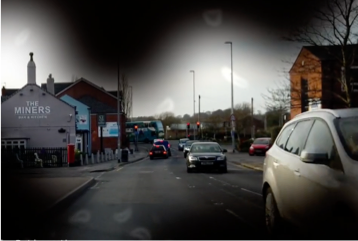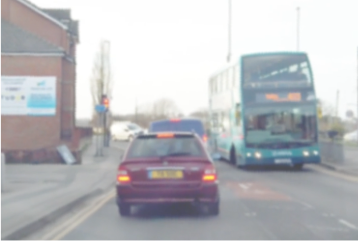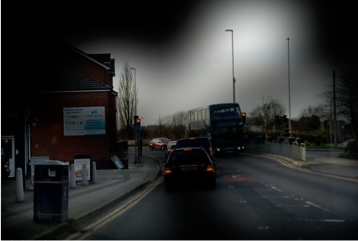The UK's eyesight is getting worse; according to the recent stats, half the planet will need glasses by 2050. Currently, the DVLA only require evidence of an eyesight test at age 75 and encourage vision checks every two years, particularly from age 60. Couple this with an aging population and the fact that there is no re-test for drivers' eyesight until they hit 75, are our roads getting less and less safe?
Some of the most common eye conditions develop after we've passed our driving test - we might not even realise how badly they're affecting our view of the road.
Age-related Macular Degeneration (AMD)
Also known as AMD, Age-related Macular Degeneration is a slow deterioration of cells in the eyes - it's the most common form of sight loss in the UK.
Age-related Macular Degeneration affects over 600,000 people in the UK, making it the leading cause of sight loss in the nation. It affects over 2.4% of over 50’s, increasing to 4.8% in people aged 65 and over, and then to 12.2% in people over 80.
AMD is caused by a degeneration of cells in the macula, which causes a loss of sight in the middle of vision, usually getting clearer towards the peripherals – it typically begins with a blurred or distorted area of vision.
 AMD can cause drivers to judge space incorrectly and miss obstructions in their path
AMD can cause drivers to judge space incorrectly and miss obstructions in their path
Other symptoms include straight lines appearing to be crooked or wavy, objects looking smaller than they usually do, dulled colours and hallucinations. AMD can cause drivers to judge space incorrectly and miss obstructions in their path.
600,000
People in the UK are affected
4.8%
Over 65’s are affected in the UK
Visit your optician if you think you could have the condition, or if it’s affecting your driving. To find out more about AMD via the NHS website.
NHS: Age-related Macular DegenerationGlaucoma
Often linked to a build up of pressure in the eye, Glaucoma is a condition which damages the eye’s optic nerve, causing sight loss.
Glaucoma is a common condition which is usually caused by intraocular pressure – pressure caused by a build-up of fluid in the eye – which damages the optic nerve. It usually affects peripheral vision first, but can continue to develop, leading to total blindness.
The condition isn’t commonly found in people under 40, but 2% of people over that age suffer from Glaucoma, rising to over 5% of those over 80 – it’s estimated that around 480,00 people in the UK have Glaucoma.
 This can be particularly dangerous when driving in the dark, as pronounced lights can dazzle more easily – which can lead to nasty accidents.
This can be particularly dangerous when driving in the dark, as pronounced lights can dazzle more easily – which can lead to nasty accidents.
Glaucoma usually doesn’t have any outstanding early symptoms and develops slowly over the years, but sufferers may notice blurred vision and rainbow coloured halos around bright lights before sight loss occurs. This can be particularly dangerous when driving in the dark, as pronounced lights can dazzle more easily – which can lead to nasty accidents.
480,000
People in the UK are affected
5%
Over 80’s are affected in the UK
If you’d like to read more about Glaucoma, visit the NHS website. If you think you may have Glaucoma, or it’s affecting your driving ability, talk to your optician.
nhs: GlaucomaDiabetic Retinopathy
The biggest cause of UK sight loss for under 60’s, Diabetic Retinopathy is caused by damage to light sensitive tissue and blood vessels in the retina.
Diabetic Retinopathy is caused by damage to the blood vessels and light sensitive tissue situated at the back of the eyeball, or retina, due to high blood sugar levels. The condition often starts without symptoms or only slightly affected vision, but can then develop to cause total blindness.
The condition affects 40% of Type 1 diabetes sufferers, and around 20% of individuals with Type 2 diabetes. Early symptoms can include floaters in vision and blurred or patchy vision, before developing into the leading cause of blindness in working age individuals.
 These issues could easily cause collisions on the roads, especially when driving at high speeds, due to increased blurriness
These issues could easily cause collisions on the roads, especially when driving at high speeds, due to increased blurriness
Those with Diabetic Retinopathy are also at double the risk of developing cataracts or Glaucoma compared to the rest of the general UK population. These issues could easily cause collisions on the roads, especially when driving at high speeds, due to increased blurriness.
40%
Type 1 diabetes sufferers are affected
20%
Type 2 diabetes sufferers are affected
If you think you may have Diabetic Retinopathy, or if it’s affecting your driving, speak to your optician. If you’d like to find out more about Diabetic Retinopathy, visit the NHS website.
nhs: Diabetic retinopathyCataracts
Cataracts is a condition, usually found in older people, where proteins in the lens of the eye clump together and form a cloudy patch which obscures vision.
The lens of the eye allows light to focus on the retina correctly for clear vision – it’s made up of water and proteins, but these proteins can clump together as we age. This causes a cloudy patch that obscures vision and can develop to cause total blindness.
Around 30% of over 65’s have visually impairing cataracts in one or both of their eyes. The condition is often linked to age, with 95% of cases occurring in people over 40 years old. Around 300,000 cataract operations take place in England alone, which aim to resolve or remove cloudy patches which cause misty or lost vision.
 This condition can lead to collisions, as obstructions and other road users can be completely missed due to lack of vision.
This condition can lead to collisions, as obstructions and other road users can be completely missed due to lack of vision.
Other symptoms include blurred vision, dulled colours, difficulty seeing in low or bright lights and frosted vision. This condition can lead to collisions, as obstructions and other road users can be completely missed due to lack of vision.
95%
Cases occuring in people over 40 years old
300,000
Cataract operations take place in England every year
If you think you may have cataracts, or feel they are affecting your driving, visit your optician. Visit the NHS website for more information about cataracts.
nhs: age related cataractsRetinitis Pigmentosa
Retinitis Pigmentosa is a hereditary condition which affects the back of the eye and causes the rod and cone cells to slowly stop functioning, causing a loss of vision.
Retinitis Pigmentosa, often known as RP, affects the retina, which is the back of the eyeball. It causes the cone cells and rods in your eyes to slowly stop functioning, which affects the ability to see properly. It’s a hereditary condition caused by a fault in the genes which produce a healthy retina.
The condition is degenerative, meaning it worsens over time, and often starts with a difficulty to see in low light conditions – sometimes referred to as “night blindness”. Early symptoms are often recognised early in life, and as the condition develops peripheral vision is lost first, narrowing the vision until total blindness.
 A loss of peripheral vision can be particularly dangerous when driving in built up areas with pedestrians crossing the road and cars turning around corners.
A loss of peripheral vision can be particularly dangerous when driving in built up areas with pedestrians crossing the road and cars turning around corners.
Other symptoms include blurred vision, dulled colours, difficulty seeing in low or bright lights and frosted vision. This condition can lead to collisions, as obstructions and other road users can be completely missed due to lack of vision.
1 in 3000
Are affected in the UK
318
Cases are reported in the UK annually
You can learn more about Retinitis Pigmentosa by visiting the RNIB website. If you think you may have the condition, or the condition is affecting your ability to drive, talk to an optician.
rnib: Retinitis pigmentosa
Hay Fever Tablets Could Land You A…
Drivers in the UK could now get a massive fine and a driving ban for taking certain types of hay fever tablets.
Read more
TOP 10: New Driver Essentials
Both learner and new drivers can find it hard to get a car that is both desirable and affordable to insure.
Read more




